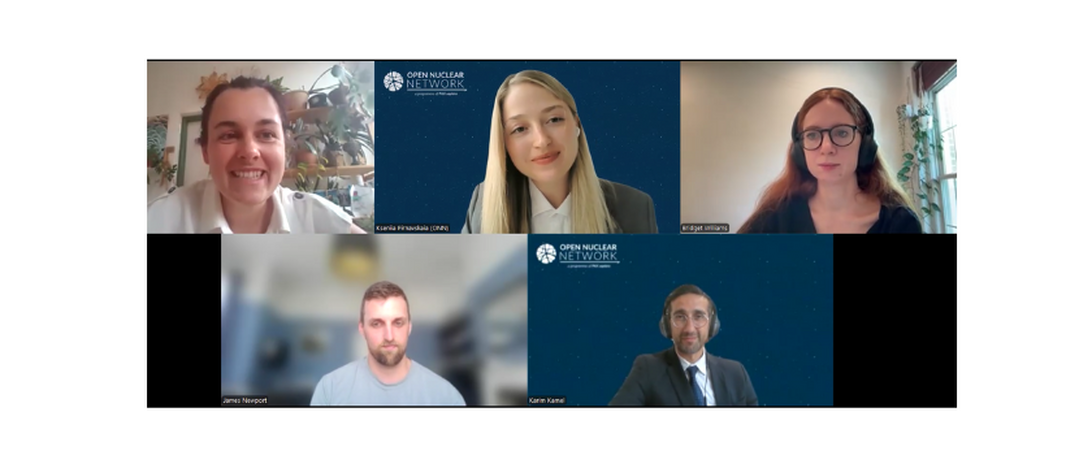
Can structured forecasting help anticipate nuclear crises before they unfold? On 8 July, ONN convened forecasting experts from Swift Centre, FRI, and Confido Institute to explore how predictive insights can help mitigate nuclear risks.
How can we anticipate the risks that nuclear policy aims to prevent? Can structured forecasting offer clarity in a field often dominated by ambiguity? On 8 July 2025, Open Nuclear Network (ONN) brought together leading voices from the forecasting community to explore these questions in a webinar titled: “Can We Predict the Next Crisis? Forecasting for Nuclear Risk Reduction.” The conversation featured expert contributors from the Swift Centre for Applied Forecasting, the Forecasting Research Institute (FRI) and the Confido Institute—three organisations actively collaborating with ONN to apply forecasting tools to the challenge of nuclear risk.
Strategic Framing: Forecasting as a Learning Loop
Karim Kamel, ONN’s Foresight and Prediction Specialist, opened the session with a strategic framing of ONN’s approach. He made a compelling case for forecasting not as guesswork, but as a disciplined, transparent process that clarifies assumptions and builds a shared vocabulary for navigating uncertainty.
“Adjectives can seduce—numbers can clarify. When an analyst replaces ‘high likelihood’ with ‘60% in the next six months,’ every hidden assumption must be defended.”
Karim explained how ONN uses probabilistic forecasting as a learning loop: each forecast includes a probability, a defined timeframe, and a brief rationale. Outcomes are later scored and revisited to refine future judgment. He highlighted the value of diverse participant groups, citing research that shows mixed groups of experts and laypeople tend to generate more original and insightful reasoning. The Delphi method supports this by reducing bias - aggregating anonymous input and fostering thoughtful discussion. Ultimately, how we bring people together matters: we design forecasting exercises that clarify perceptions and cultivate an inclusive space for exchange and collaboration.
Partner Contributions: Forecasting in Action
James Newport, Swift Centre for Applied Forecasting, highlighted, the value of conditional forecasting - breaking down complex scenarios like nuclear conflict into precursor events to better guide real-time decision-making. He described how Swift’s work on India–Pakistan tensions and the Israel–Iran conflict provided rapid-turnaround forecasts to inform strategic responses within 12 hours.
“In crises, days, even hours, matter. Forecasting helps us identify what to watch and when to act.”
Bridget Williams, Forecasting Research Institute (FRI), shared key findings from FRI’s collaboration with ONN, which surveyed 151 participants — including nuclear experts and superforecasters — on the likelihood of a major nuclear catastrophe by 2045. She also highlighted insights on risk-reduction policies. Among the six policies evaluated, crisis-communication networks and fail-safe reviews received the highest scores for their potential to reduce risk. Looking ahead, the work points to the need for improved elicitation techniques, stronger team dynamics, better aggregation methods and broader integration of forecasting into nuclear risk efforts.
Blanka Havlíčková, Confido Institute, emphasised the human dynamics of forecasting: the importance of creating psychologically safe environments, normalising doubt and designing workshops where participants can express uncertainty without fear. Forecasting is most effective when people feel comfortable admitting what they don’t know and are encouraged to update their views as they learn. Her team helps organisations strengthen internal forecasting through workshops that focus on: formulating clear questions, being transparent about what is known and unknown, and fostering group dynamics that prioritise psychological safety, particularly for domain experts new to forecasting.
Panel Highlights: Tackling Skepticism, Bias and Application
The expert panel explored several critical themes:
- Forecasting and Skepticism: While growing in popularity, forecasting still faces resistance in nuclear policy. Speakers underscored that forecasting simply makes implicit predictions explicit, allowing better evaluation and decision-making.
- Superforecasters vs. Experts: The panelists clarified that superforecasters stand out not because of deep subject-matter expertise, but due to their structured reasoning and careful calibration. While expert knowledge remains essential, it’s most powerful when paired with rigorous forecasting methodology. The combination of expert insight and superforecaster calibration tends to yield the most robust policy guidance. They also noted that incentives differ between the groups: superforecasters are typically rewarded for accuracy.
- Lessons from Other Fields: From biosecurity to AI risk, forecasting is being used to inform safety protocols and policy frameworks. These lessons are increasingly relevant to nuclear risk as well.
- Encouraging Action: Practical forecasting exercises, when grounded in clear, context-relevant questions, can empower institutions to act, not just reflect.
Final Reflections: Can We Predict the Next Nuclear Crisis?
As the session closed, panelists were asked the overarching question: Can we truly predict the next nuclear crisis? The consensus was clear: perhaps not with certainty, but we can significantly improve our chances. By breaking down risks into observable components, designing inclusive exercises, and integrating policy voices from the outset, forecasting becomes a catalyst for clearer thinking and strategic foresight. Thinking systematically about risk pathways can help to reduce the chances of nuclear risk.
Stay Informed: To receive updates on ONN’s future events and research, subscribe to our newsletter and follow our partners’ work at the Swift Centre for Applied Forecasting, Forecasting Research Institute (FRI) and Confido Institute.